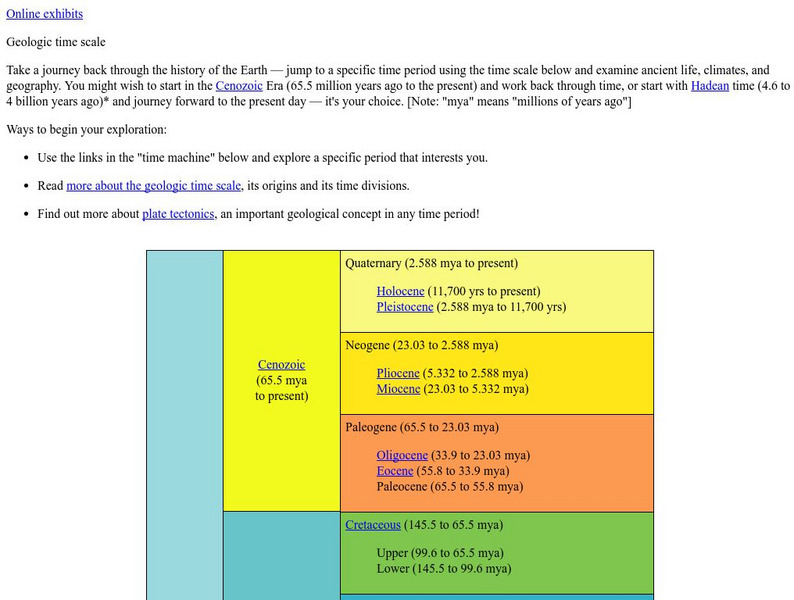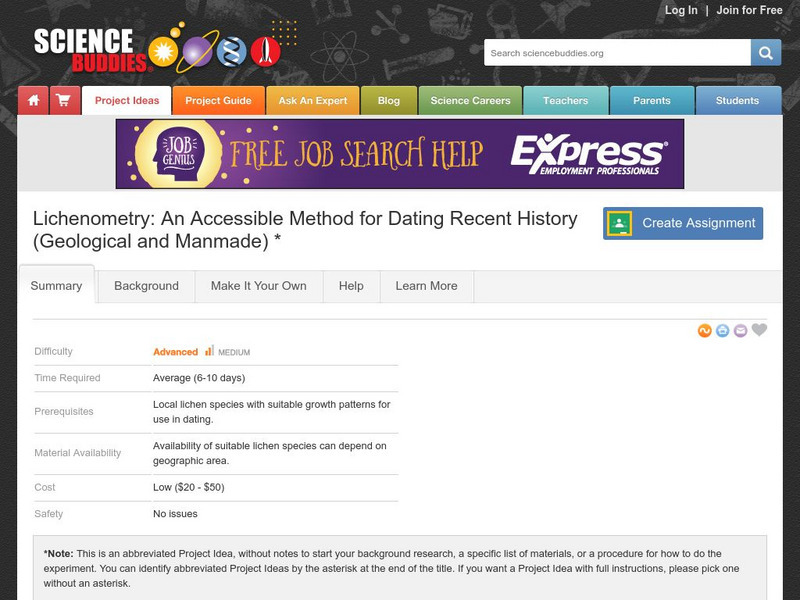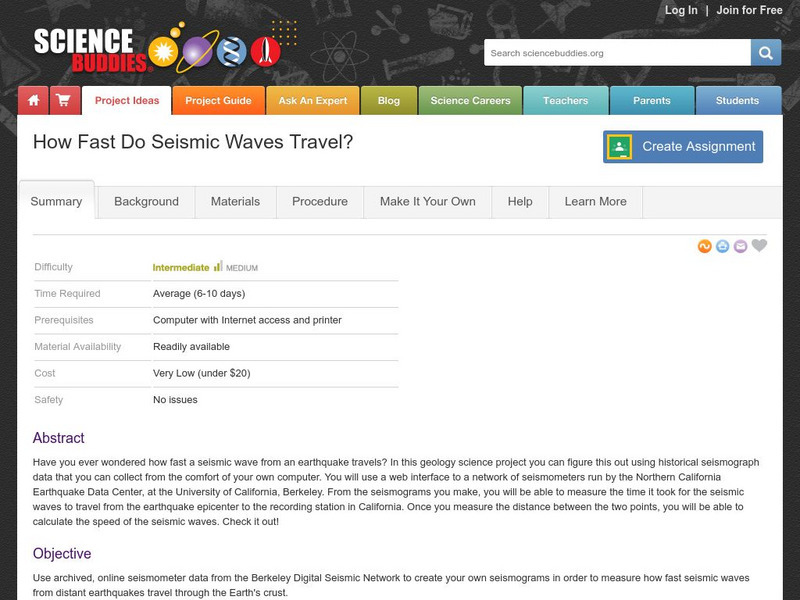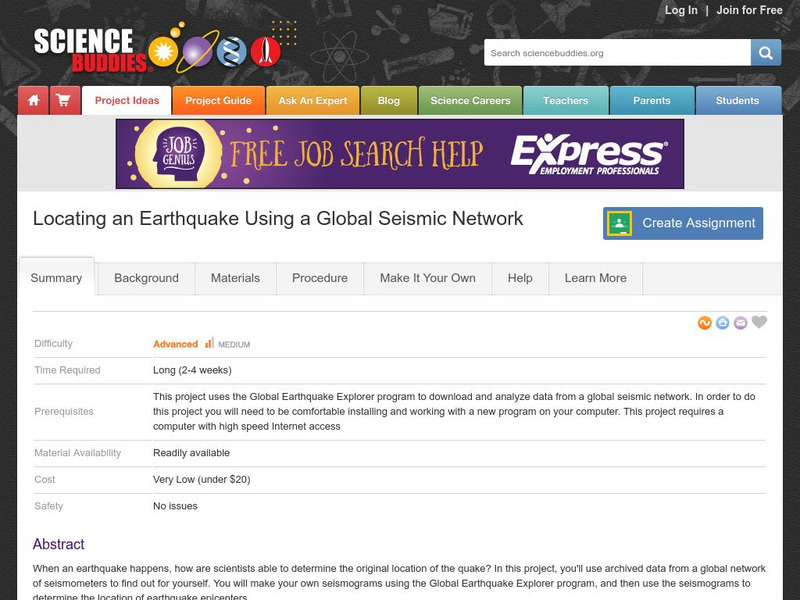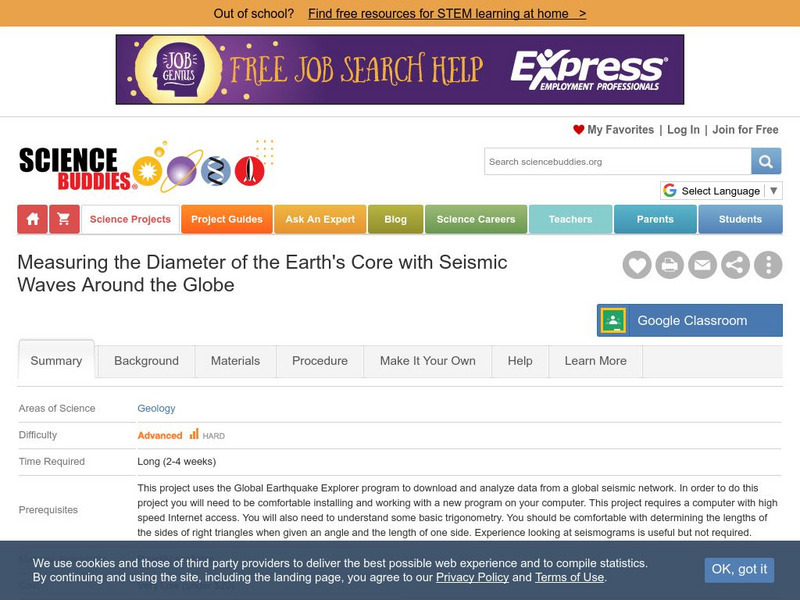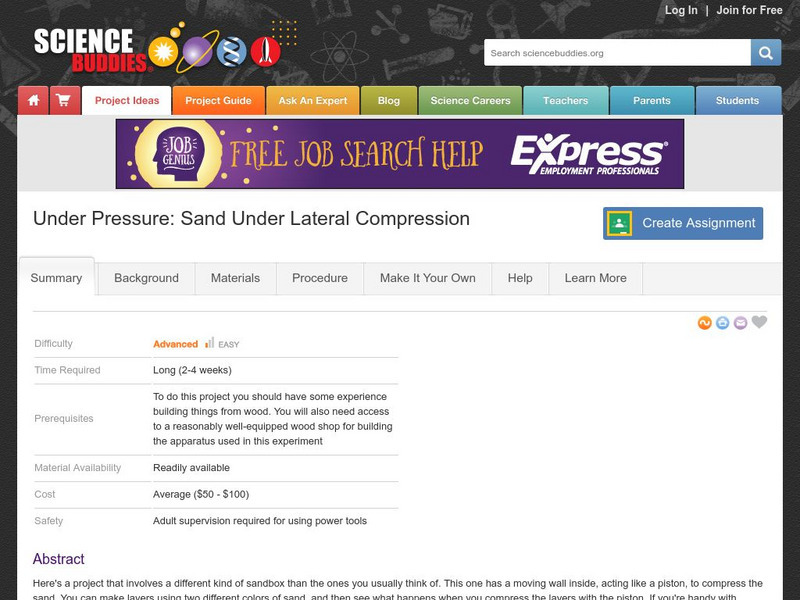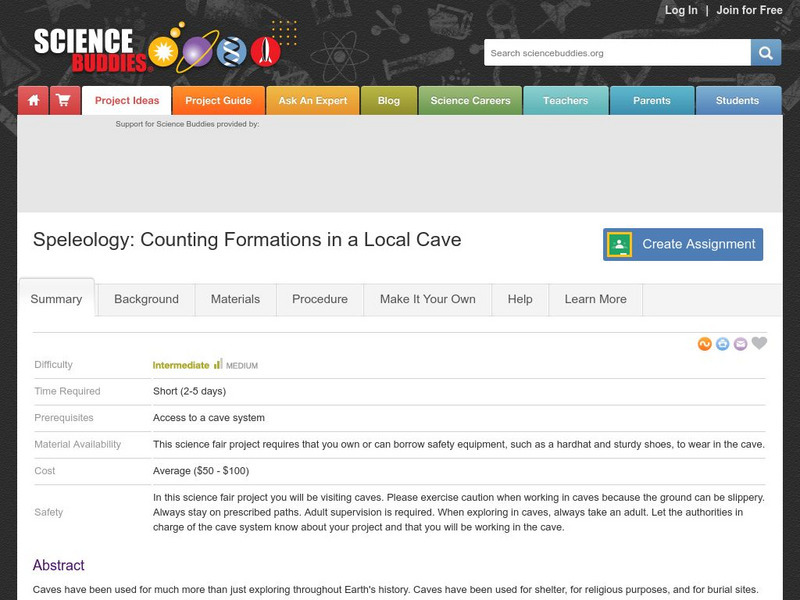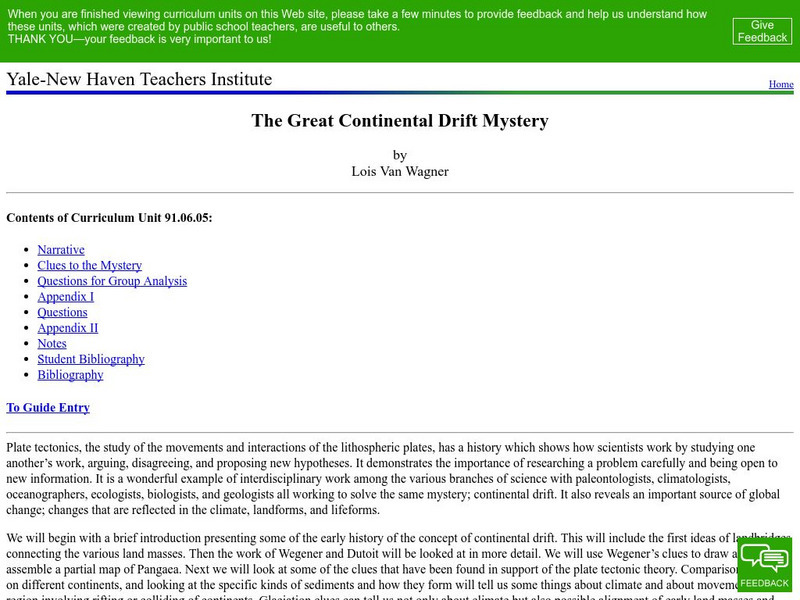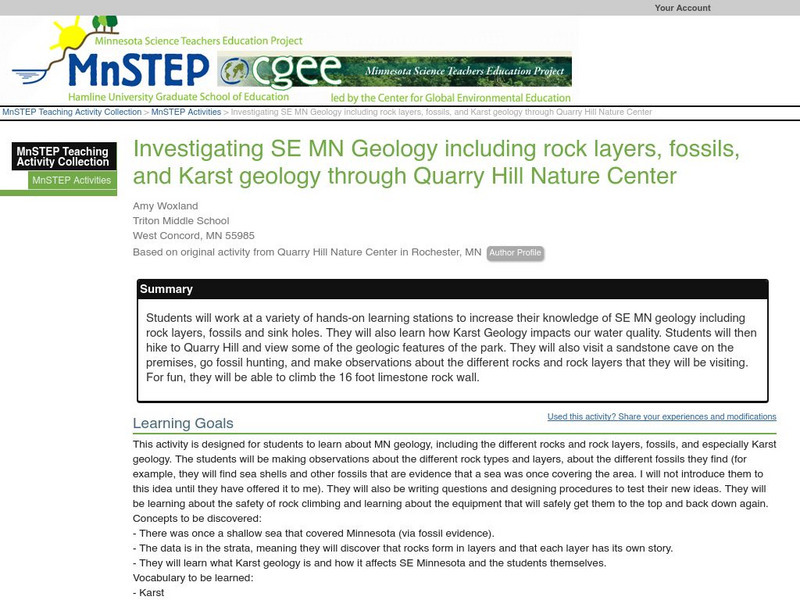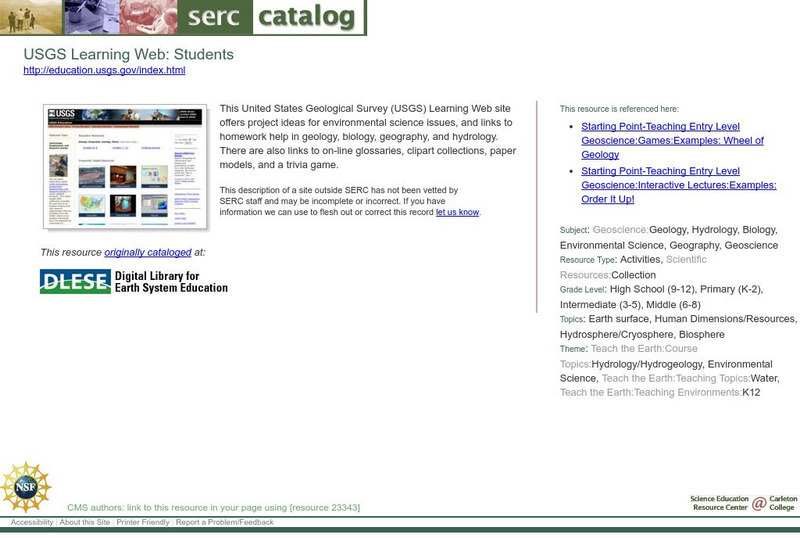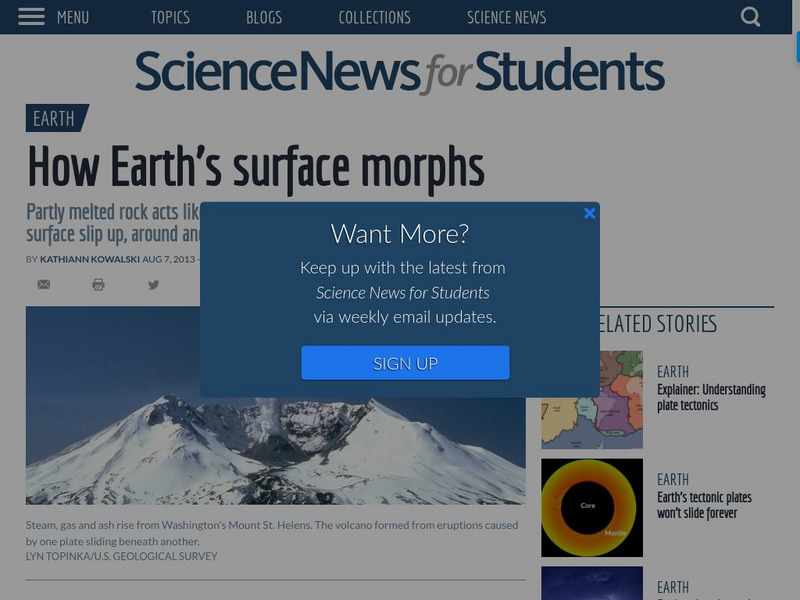Burke Museum
Burke Museum: The Big One
This is the introduction to the Burke Museum's online exhibit on earthquakes and natural disasters. This is part of the Burke Museum's collection of geology. Topics that are covered include an introduction to quakes, quake science, quake...
University of California
Ucmp: Web Geological Time Machine
The Museum of Paleontology at Berkeley offers an online geological time machine which allows you to catch a glimpse of ancient eras in earth's history. Click into an "Era" to learn about its stratigraphy, life forms, localities, and...
University of Michigan
Photoglossary/geysers
Describes how a geyser works and provides a nice diagram of the geological structure of a geyser.
PBS
Pbs Learning Media: The World of Volcanoes
In this segment from Nature, Scientists travel to the top of Mount Kilauea to collect molten lava samples for testing.
Science Buddies
Science Buddies: Liquefaction & Seismic Activity
Earthquake damage can be intensified in areas that are subject to soil liquefaction. For example, in these areas, soil movement may cause foundations to collapse, while structures in nearby areas built on more stable soil or bedrock may...
Science Buddies
Science Buddies: Lichenometry: An Accessible Method for Dating Recent History
Geology and archeology are examples of historical sciences. Their practitioners rely on multiple methods for establishing dates and temporal sequences as they seek to construct a history from the available evidence. This project will...
Science Buddies
Science Buddies: Soil Compaction
Have you ever had to dig a hole in really hard dirt? It is a lot of work. In this experiment you can make an instrument to test the soil and find out how compacted it is, before you dig.
Science Buddies
Science Buddies: Soil Color and Moisture
When you step in mud it can be very messy. How can you tell if soil is wet or dry before you step in it? In this experiment, you can see if color can help you figure it out.
Science Buddies
Science Buddies: Porosity and Particle Size
Often, when we think of something that is solid we think about rocks. But in reality, rocks have tiny holes of air inside them. This is called porosity. In this experiment you can find out what it means to be "solid as a rock."
Science Buddies
Science Buddies: Sorting Out Sedimentation
Sedimentary rock forms in layers that are deposited one after the other over long periods of time. Oftentimes, sedimentary rock contains fossils and other debris that are deposited within the layers. Use this experiment to investigate...
Science Buddies
Science Buddies: Underground Water Flow and Darcy's Law
This project shows you how to build a simple model system to simulate underground water flow. Underground water flow is important for understanding replenishment of underground aquifers, migration of underground contaminant plumes, and...
Science Buddies
Science Buddies: How Fast Do Seismic Waves Travel?
Here's a geology project that uses historical seismograph data that you can collect from the comfort of your own computer. You'll use a web interface to a network of seismometers run by the Northern California Earthquake Data Center, at...
Science Buddies
Science Buddies: Locating the Epicenter of an Earthquake
When an earthquake happens, how are scientists able to determine the original location of the quake? In this project, you'll use archived data from a network of seismometers to find out for yourself. You'll create your own seismograms...
Science Buddies
Science Buddies: Ring of Fire 2: What Earthquakes Tell Us About Plate Tectonics
The theory of plate tectonics revolutionized geology in the 1960's. In this project you can explore the connection between plate tectonics and earthquakes by mapping historical seismic data.
Science Buddies
Science Buddies: Locating an Earthquake Using a Global Seismic Network
When an earthquake happens, how are scientists able to determine the original location of the quake? In this project, you'll use archived data from a global network of seismometers to find out for yourself. You will make your own...
Science Buddies
Science Buddies: Measuring the Earth's Core With Seismic Waves
When an earthquake occurs, seismic shock waves travel out through the earth from the source of the event. The shock waves travel through the earth (body waves), or along the Earth's surface (surface waves), and can be recorded at remote...
Science Buddies
Science Buddies: Beach Bum Science: Compression of Wet Sand
Did you ever notice the cool patterns around your footprints when you take a walk in the wet sand at the beach? The pressure of your feet has effects far outside your footprints. Here's a project that uses a simple experimental apparatus...
Science Buddies
Science Buddies: Under Pressure: Sand Under Lateral Compression
Here's a project that involves a different kind of sandbox than the ones you usually think of. This one has a moving wall inside, acting like a piston, to compress the sand. You can make layers using two different colors of sand, and...
Science Buddies
Science Buddies: Speleology: Counting Formations in a Local Cave
In the past caves have been used for shelter, for religious purposes, and for burial sites. They were even used for food storage before refrigeration, because they are cool and have constant high humidity. Get ready for an adventure as...
Yale University
Yale New Haven Teachers Institute: The Great Continental Drift Mystery
A unit on plate tectonics designed for middle school students, this page must be read carefully to find the activities to be done in the class, but it provides a wealth of background for the teacher as well.
Science Education Resource Center at Carleton College
Serc: Investigating Se Mn Geology Incl Rock Layers, Fossils, and Karst Geology
Students will work at a variety of hands-on learning stations to increase their knowledge of SE MN geology including rock layers, fossils and sink holes. They will also learn how Karst Geology impacts our water quality. Students will...
Science Education Resource Center at Carleton College
Serc: Usgs Learning Web: Students
Project ideas for environmental science issues, and links to homework help in geology, biology, geography, and hydrology.
Talk Origins Archive
Talk Origins Archive: Radiometric Dating and the Geological Time Scale
A lengthy article with lots of information about radiometric dating, including pictures and charts.
Society for Science and the Public
Science News for Students: How Earth's Surface Morphs
Article reports on how the surface of the Earth changes over time. Includes a list of vocabulary words from the article.



